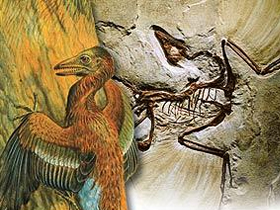With every new fossil discovery, evolutionists engage in speculation on the link between birds and dinosaurs. However, detailed analyses constantly refute the conjecture that these fossils constitute evidence for reptile-to-bird evolution.
A report titled “Feathered Dinosaur Fossils Unearthed in China” in National Geographic magazine in 1996 was thought to represent definitive proof of evolution. But there was an error and a lack of knowledge here. Since there is no evidence that feathered dinosaurs evolved, the report concerning them later proved fictitious.
The article dealt with three theropod dinosaur fossils discovered in China. Great media propaganda sought to portray these as important evidence for evolution. Even in Turkey, certain media organizations devoted wide space to those specious claims.
According to the information provided in National Geographic, all three fossils are around 120 million years old, and members of the theropod dinosaur class. (A theropod is the name given to such carnivorous dinosaur species as Tyrannosaurus rex and Velociraptor.) However, National Geographic also maintained that these dinosaurs had bird-like characteristics. These fossil dinosaurs were covered in feathers, similar to those in birds.
Over the months that followed, however, detailed analysis of the fossil known as Sinosauropteryx showed that the structures evolutionists had described as bird feathers were in fact nothing of the sort. An article in Science magazine called “Plucking the Feathered Dinosaur” stated that the structures evolutionist paleontologists portrayed as feathers actually had nothing to do with feathers at all:
Exactly 1 year ago, paleontologists were abuzz about photos of a so-called “feathered dinosaur.” . . The Sinosauropteryx specimen from the Yixian Formation in China made the front page of The New York Times, and was viewed by some as confirming the dinosaurian origins of birds. But at this year’s vertebrate paleontology meeting in Chicago late last month, the verdict was a bit different: The structures are not modern feathers, say the roughly half-dozen Western paleontologists who have seen the specimens. . . . .Paleontologist Larry Martin of Kansas University, Lawrence, thinks the structures are frayed collagenous fibers beneath the skin—and so have nothing to do with birds.162
Following the failure of their speculation with regard to Sinosauropteryx, evolutionists moved their attention to new fossil discoveries known as ArchBEoraptor, Sinornithosaurus and Beipiaosaurus. (See Archaeoraptor). A dogmatic approach to evolution, a lack of thought and belief in a preconception lead to such errors and erroneous interpretations. The fossils in question establish no connection between birds and dinosaurs, but rather raise a number of inconsistencies and contradictions, some of which may be summed up as follows:
The fossils discovered in China and known as ArchBEoraptor, Sinornithosaurus and Beipiaosaurus are depicted as part birds and part dinosaurs. The evolutionist paleontologist Chris Sloan who interpreted the fossils suggests that these creatures were unable to fly, but used their wings for balance when running. In other words, they need to be regarded as the forerunners of birds and were as yet incapable of flight.
There is an enormous inconsistency here, because these fossils are only 120 million years old. Yet Archaeopteryx, the oldest known bird, is already 150 million years old. Archaeopteryx had exactly the same flying ability as modern-day birds. It possessed the requisite broad wings, asymmetric and complex feather structure and sternum (breast) bone for flight. Evolutionists have for long attempted to portray Archaeopteryx as the primitive forerunner of birds. Yet the greatest problem they face is that this vertebrate already possessed all bird-like features and was fully capable of flight.
In short, Archaeopteryx proves that ancient birds were flying through the air 150 million years ago. This naturally makes it impossible for fossil dinosaurs that are younger by 30 million years to be regarded as the primitive forerunners of birds that were as yet incapable of flight. This shows an evident contradiction in evolutionist claims regarding ArchBEoraptor, Sinornithosaurus and Beipiaosaurus.


